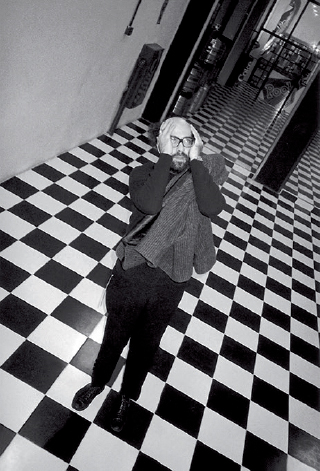 Fernando Zarif no Projeto SP, s/d
Fernando Zarif no Projeto SP, s/d
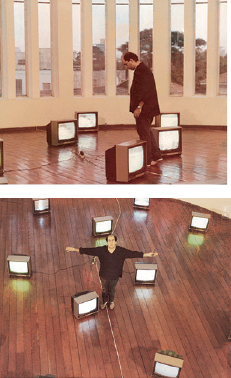
Videoinstalação realizada no MIS – Museu de Imagem e
do Som, São Paulo, 1983
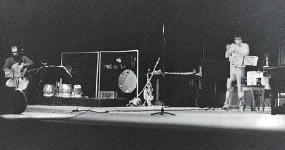
Acima Fernando toca chello em concerto, ao lado em performance. MASP – Museu de Arte de São Paulo, s/d

Gravação do programa Rádio Paradiso, na Rádio USP. Acima, o artista aparece em primeiro plano, da esq. para a dir.: a artista plástica Jac Leirner, o jornalista Arthur Veríssimo e Mae East no estúdio da rádio,1986

Cartaz de divulgação da ópera Frankenstern no MASP, 1984. Projeto gráfico e ilustração de Fernando Zarif

Imagens do catálogo da exposição PARA)DOXOLOGIA na Galeria Millan, 1989. Projeto gráfico de Fernando Zarif

Imagens da abertura da exposição PARA)DOXOLOGIA, publicadas na coluna da jornalista Joyce Pascowitch, no jornal Folha de S.Paulo, em 20 de setembro de 1989, p. 2. Da esquerda para direita: Dani Roland, Giulia Gam e Murilo Salles
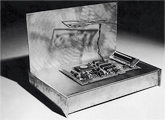
Obra O espírito deixa o corpo, que integrava a exposição PARA)DOXOLOGIA na Galeria Millan, 1989
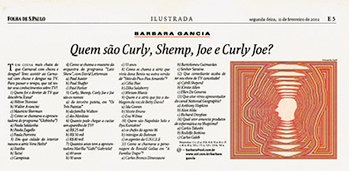
Ilustração para a coluna de Barbara Gancia, no Caderno Ilustrada do jornal Folha de S.Paulo, 2002
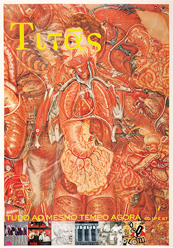
Arte realizada por Fernando Zarif para o cartaz do álbum TUDO AO MESMO TEMPO AGORA, da banda Titãs, 1991
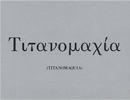
Convite para o lançamento
do álbum TINANOMAQUIA,
da banda Titãs, cuja capa foi
desenhada por Zarif, 1993

Capa do folder da exposição Chuva – Desenhos e Cartas, na Galeria Millan, 1990. Arte e projeto gráfico de Fernando Zarif
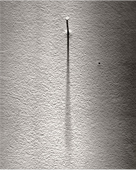
Capa do catálogo Fernando Zarif, na Galeria Millan, São Paulo, 1993. Projeto gráfico de Fernando Zarif

Capa do catálogo e fotosda exposição O Corpo Humano e Outros Corpos, de Fernando Zarif, no MAM/RJ – Museu de Arte Moderna do Rio de Janeiro, 1995
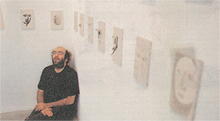
Fernando Zarif na exposição Operação Pl.stica, na Galeria Millan, São Paulo. Imagem publicada no jornal Folha de S.Paulo, em 30 de outubro de 1997

Fotos da exposição 555, de Fernando Zarif, realizada na Galeria Millan, 1994
 Fotos da exposição 555, de Fernando Zarif, realizada na Galeria Millan, 1994
Fotos da exposição 555, de Fernando Zarif, realizada na Galeria Millan, 1994
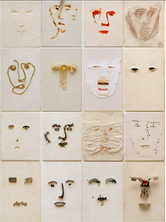
Folder da exposição Le Mus.e
imaginaire de Fernando Zarif,
na Maison Des Arts Andr.
Malraux, Cr.teil, Fran.a, 1998

Fernando Zarif na exposição Le Mus.e imaginaire de Fernando, na Maison Des Arts Andr. Malraux, Créteil, Fran.a, 1998

Fernando Zarif: Timeline Notes
|
|
|
Erudition was one of the most striking features of Fernando Zarif, as remembered by all artists, journalists, musicians, set designers, actors, film directors, playwrights and designers who knew him. However, the artist’s intellectual trajectory did not follow a conventional path. He stepped out of traditional education when he finished high school at São Paulo school Dante Alighieri. He started an Architecture degree course, but did not complete it. He would choose informal education, with free courses and one-to-one lessons. Poet Décio Pignatari and musician Hans-Joachim Koellreutter have been his teachers. During his life, he has developed his own system of reflection on and study of the issues that he found most interesting: the arts, religions, and ancient myths. He started to draw at the age of two and a half. At the age of eight, Pietro Maria Bardi said during a visit that the child had drawn “extraordinary graphic elements”. He used to spend a lot of time with his maternal grandfather, Lebanese poet Chafic Maluf, who would tell him stories of the mythology of his home country. The bookstore of his mother, May Zarif, has been for years a gateway to the numerous books that make up his library. He was introduced to major museums, operas and international dance performances from an early age. He always lived in São Paulo, but enjoyed traveling regularly to New York, Paris and Venice. He has been to Japan and China. He has also been to Lebanon, where he was fascinated by the local light, the ruins, the Phoenicians. The family farm in Botucatu, in the countryside of São Paulo, was an important place not only during childhood but also into adulthood, where he would take refuge to create. He was familiar with the great classics of Western philosophy and studied Greek. But he also read with great interest everything he could get his hands on about Eastern philosophy. He was particularly interested in the study of religions, oracles, and the sacred. His taste for the classics and the transcendental, however, did not prevent him from admiring Woody Allen’s movies or enjoying jazz – Cole Porter was his favorite. Pop culture and classical references were present in his daily life and in his works too. Richard Wagner was by far his favorite artist. Perhaps such a fondness is due to Zarif’s affinity with the idea of total work of art (Gesamtkunstwerk in German), as advocated by the German composer. Zarif’s works involve visual arts, theater, music, video art, literature… Although he did not like the term “multimedia”, it is worth noting that his work happens at the convergence of various media and subjects. He would draw, photograph and later began to make objects. At the same time, he liked music and played the tabla and guitar. He composed pop songs and produced, among other graphic pieces, the covers of the albums, “Titanomaquia”, 1993 (the album title was given by Zarif) and “Tudo ao mesmo tempo agora”, 1991, by Brazilian rock band Titãs. He designed sets for plays. He did illustrations for the column of journalist Barbara Gancia in the Folha de São Paulo newspaper in the early 2000s. He worked in a diverse and wide range of fields. These timeline notes are the first attempt to gather some important facts about his career. |
|
| 1960 | Fernando Zarif was born in the city of São Paulo. |
| 1979 | He attended for about three years the Architecture program at Federação das Faculdades Braz Cubas, currently University of Mogi das Cruzes, a university in the countryside of São Paulo. |
| 1982 | At the age of 21, he held his first solo exhibition at the Gabinete Fotográfico space, at Pinacoteca do Estado de São Paulo. He showed one hundred color photographs taken with his Polaroid SX-70. |
| 1983 | He put in, as part of the Music program of the MASP (São Paulo Museum of Art) auditorium, the performances Dois Movimentos, Concerto Plástico Digital I [Two Movements, Digital Plastic Concert I] and ConcertoPlásticoDigital II [Digital Plastic Concert II], with music by Richard Wagner and John Cage.
In a performance held at Avenida Paulista, in front of the Trianon Park, “Projeto/Construção de um encontro em cinza para tipos cinzentos ao amanhecer” [Project/Construction of a meeting in gray for grayish types at dawn], Fernando Zarif and eight other people sat around a table with gray flowers, fruit, dishes, and cutlery. A dancer and a waiter would walk around and serve the other performers, who were still at first and then began to eat and talk. The work lasted from 6 a.m. to 11 a.m. and was seen by the passers-by. He held a video installation at MIS (Museu de Imagem e do Som), São Paulo. |
| 1984 | He participated in the Contemporary Music Ensemble at Sesc Pompéia, São Paulo. The event brought together the most important names of the artistic avant-garde, such as conductors H.J. Koellreutter and John E. Boudler; Brazilian pianist and composer Jocy de Oliveira, and singer Ana Maria Kieffer. At the event, Zarif put in the Concert performance together with musician and architect Emanuel de Melo Pimenta. The work included a computer, saxophone, trumpet, trombone, tape, synthesizer, singers, dwarf actors, and a samba school. The performance was produced by Emanuel and based on texts by writers Guimarães Rosa, Jorge Luis Borges and others.
He carried out another project with artist Emanuel de Melo Pimenta at Paço das Artes, São Paulo. The work involved handling static electricity and included remote controls and twenty TV sets. At the same time, slides would project TV images taken with a macro lens. The song, Torre de Babel/Esperanto [Tower of Babel/Esperanto], produced by Melo, could be heard in the background. Presented electronic minimalist opera “FRANKENSTERN” together with poet and writer Décio Pignatari and Emanuel de Melo Pimenta at MASP. The performance, which was designed and delivered by means of videos, synthesizers and computers, was based on the book “Frankstein” by Mary Shelley (1821) and the biblical texts of Genesis. Twelve TV sets were installed in the set – each set would show one of the twelve body parts of “Frankenstern”. The futuristic creature was represented by several performers whose performances were recorded by Zarif. In addition to the videos shown, the TV sets were carried by twelve performers wearing black, in choreography. The entire soundtrack was composed by Emanuel, featuring singers Ana Maria Kieffer, Magali Mussi, Madalena Bernardes, Claudia Matarazzo, Ghandula, and pianist Aimár César. The performance was held in a single evening (December 12) and lasted 1 hour and 20 minutes. |
| 1986 | Participated in a group exhibition with Theo Castilho and Isabelle Van Oost at gallery restaurant Vol de Nuit, Paris.
Produced and presented the Rádio Paradiso program (a program on contemporary classical music) on Saturday night on radio USP (93.7 MHz) together with journalist Arthur Veríssimo. On one of those programs, the artist intended to make an adaptation of the radio play, To Have Done with the Judgment of God by French playwright Antonin Artaud (1896-1948). The performance, in which Marcelo Tas, Pepe Escobar, João de Bruço and Veríssimo would participate, was censored and suspended even before going on the air by Mário Fanucchi, broadcaster and professor at the School of Communications and Arts of the University of São Paulo (ECA-USP), who had just taken office as the radio director. The censorship was very controversial and mentioned on various media. |
| 1988 | Participated in group exhibition 1/88 at the Montesanti gallery, São Paulo, together with other young artists of the time: Márcio Antonon, Marina Godoy, Neuza Petti, Ricardo Barreto, and Jacqueline Terpins. Twenty-three works were shown in the group exhibition organized by curator Miguel de Almeida.
Fernando showed paintings that stood between figuration and abstraction, with recognizable forms and moments of material experimenting with acrylic paint on canvas. The exhibition opened the gallery program for the year 1988. Participated in the Não Intencional [Unintentional]art auction at MAC (Museum of Contemporary Art of the University of São Paulo). Personal items of artists like Leda Catunda, Cláudio Tozzi, Aldemir Martins, José Roberto Aguilar, among others, were shown on the occasion. The purpose of the event, which was organized by Artur Matuck and Tadeu Jungle, was to parody the auction of the collection of pop artist Andy Warhol, who shook the art market in New York at the time. The event was part of the activities to celebrate the 25th anniversary of the museum. Participated in musical group Vestidos de Espaço in partnership with the members of Brazilian rock band Titãs, Branco Mello, Arnaldo Antunes and Charles Gavin, singer Paula Toller, musician Jorge Mautner, and producer Liminha. The group released only a single featuring two songs, “Pipi Popô” and “Marcha do Demo”, which were signed by Zarif under the pseudonym Pepino Carnale. Fernando was one of the group stunt performers and would go on stage wearing a mask. At the time, nobody knew who the band members were, who were only revealed after the group disappeared. Directed and produced the Phoenix, Sisyphus and Prometheus performance at theAeroanta space in São Paulo, together with musical group Pizzicato Bartock. |
| 1989 | Held solo exhibition Para)doxologia [Paradoxology] at the Millan Gallery, São Paulo. The exhibition featured eighteen small objects and five drawings. The objects included “INRI”, 1989, a crucifix with dice glued on a marble plate; “Ósculo”, 1989, two glasses glued facing each other, among other assemblages. Small table works, the objects were born when the artist moved from his place – he had no painting studio. “I was taking things out of a box and a friend had left a superglue; I started gluing an object to another as they would come together on my mind”, the artist said in an article by Cláudio Lucchesi Cavalca, published in the Jornal da Tarde newspaper on September 22, 1989. Journalist Pepe Escobar also wrote about this exhibition in O Estado de São Paulo newspaper on September 30, 1989, “Zarif’s ready-mades may represent a total collapse of the sense in contemporary culture”, according to him, the works shown in the gallery were “spiritual daughters of Man Ray, Duchamp and Picabia”. Adriana Adam was in charge of the lighting and Geraldo Anhaia Mello was in charge of the video projection in the opening of the exhibition. |
| 1990 | Held solo exhibition Chuva – Desenhos e Cartas [Rain – Drawings and Letters] at the Millan Gallery, São Paulo, featuring drawings on paper and drawings on printed maps. |
| 1993 | Held solo exhibition Fernando Zarif, featuring ten 50 x 60 cm paintings (mixed technique), nine of which inspired by Greek myths and one inspired by “Mona Lisa”, and an installation including sculptures entitled Auréolas [Halos] at the Millan Gallery, São Paulo. Auréolas were small rounded pieces made of various materials, such as glass and metal, nailed to the wall and lit from above so as to project an intense shadow. |
| 1994 | Held solo exhibition 555 including paintings, photos and texts at the Millan Gallery, São Paulo. The title of the exhibition refers to the approximate date of birth of Heraclitus of Ephesus, Laozi and Buddha. The artist believed that the three thinkers, who “pondered on the ineffable, the fifth dimension, the collective unconscious, the absolute with different points of view”, shared a close similarity. The text accompanying the exhibition – which was written by the artist two years before – had an affinity with the works shown and therefore was included in the exhibition. |
| 1995 | Held a solo exhibition at the Rio de Janeiro Museum of Modern Art, O Corpo Humano e Outros Corpos [Human Body and Other Bodies].The exhibition featured thirteen works and was his largest exhibition in a Brazilian institution. He showed some self-portraits: “Time is Money”, date unknown, a 1.82-m high pile of coins joined together by a copper thread, “Quinze anos depois” [Fifteen years later], date unknown and 1.82m high, consisting in a pile of metal keys and two photos showing replicated, overlapping parts of the artist’s face. In addition to the self-portraits, other works also refer to human body parts like the spine, skin, skeleton, and others.
Participated in the group exhibition, 2nd United Artists: Utopia, at Casa das Rosas, São Paulo. |
| 1997 | Participated in the group exhibition, Arte Suporte Computador [Computer Support Art], at Casa das Rosas, São Paulo.
Held solo exhibition Operação Plástica [Plastic Surgery], at the Millan Gallery, São Paulo. He showed 250 small artworks – 14 x 22cm and 15 x 18cm – featuring faces made of materials like glue, zipper, tweezers, pen, cigarette, incense, lead, brush, hair, marble, among others. At the entrance of the gallery, the artist presented a section of the book, On the Origin of Species byBritishnaturalist Charles Darwin (1809-1882). Fernando Zarif said to the then editor of the Ilustrada section of the Folha de São Paulo newspaper, Sérgio Dávila: “Movement and modernist are redundant terms – it is the same as saying desert and Sahara; I try to find a way back to the modern of the modern age, I’m interested in Newton and Darwin. Hence the portraits, the faces.” (FSP, October 30, 1997, p.5). |
| 1998 | Held solo exhibition Le Musée Imaginaire de Fernando Zarif, at Maison Des Arts André Malraux, in Créteil, France. This was the artist’s largest exhibition and included works done over the past ten years. One of those works was a set of approximately 190 small portraits entitled “Cirurgia estética” [Cosmetic surgery], 1997, which were part of the exhibition “Operação Plástica” [Plastic Surgery], in addition to 50 other works. Drawings on maps, such as “Europa” [Europe], 1989, large sculptures like “Calvário” [Calvary] 1995, and “INRI – Cruz de pregos” [INRI – Cross of nails], 1998, were shown together with a series of other paintings and drawings. |
| 2009 | Participated in the exhibition, Inventário do Tempo: Livros [Time Inventory: Books], curated by Bia Lessa and Maria Borba at Espaço Tom Jobim, at the Rio de Janeiro Botanical Garden. In his last appearance, Cadernos [Notebooks], Fernando shows his notebooks of drawings produced during nearly two years, made of graphite, adhesive tape, feathers, silk, staples, gouache, oil and charcoal, among other materials. The notebooks – described by the artist as a “discourse on drawing” – would be flicked through page by page on a table for three hours, while a camera would record and project the images on a screen. The event Inventário do tempo: Livros included other performances, debates, gastronomical and musical experiences with various artists throughout June. The activities were part of the process of creation of the Formas Breves [Brief Shapes] show by Bia Lessa and Maria Borba. |
| 2010 | He died at the Sírio-Libanês Hospital in São Paulo. |
| 2011 | The artist’s family started the Fernando Zarif Project, designed to catalog, preserve and disseminate his work. Situated in São Paulo, the project is home to the artist’s personal library, documents, photos and writings on his work. So far, approximately 2,000 works have been cataloged and restored. |
